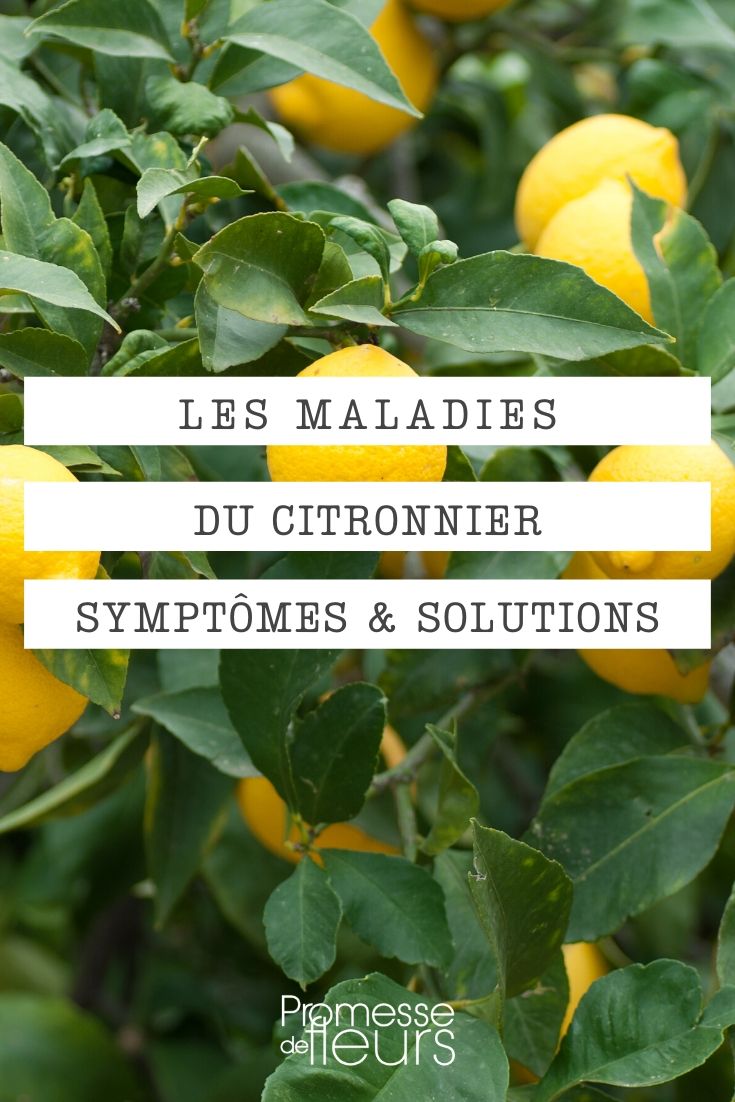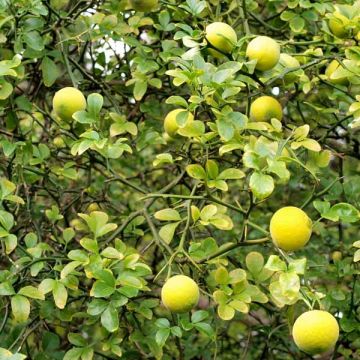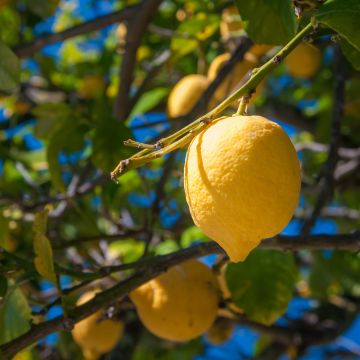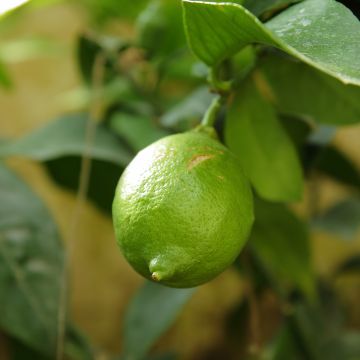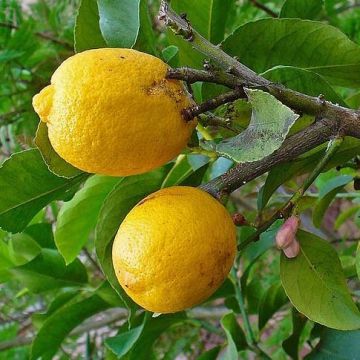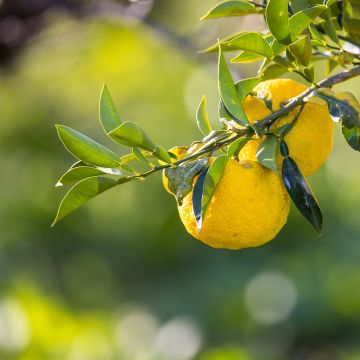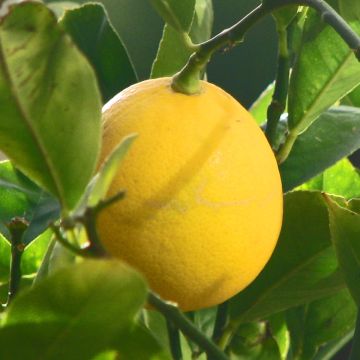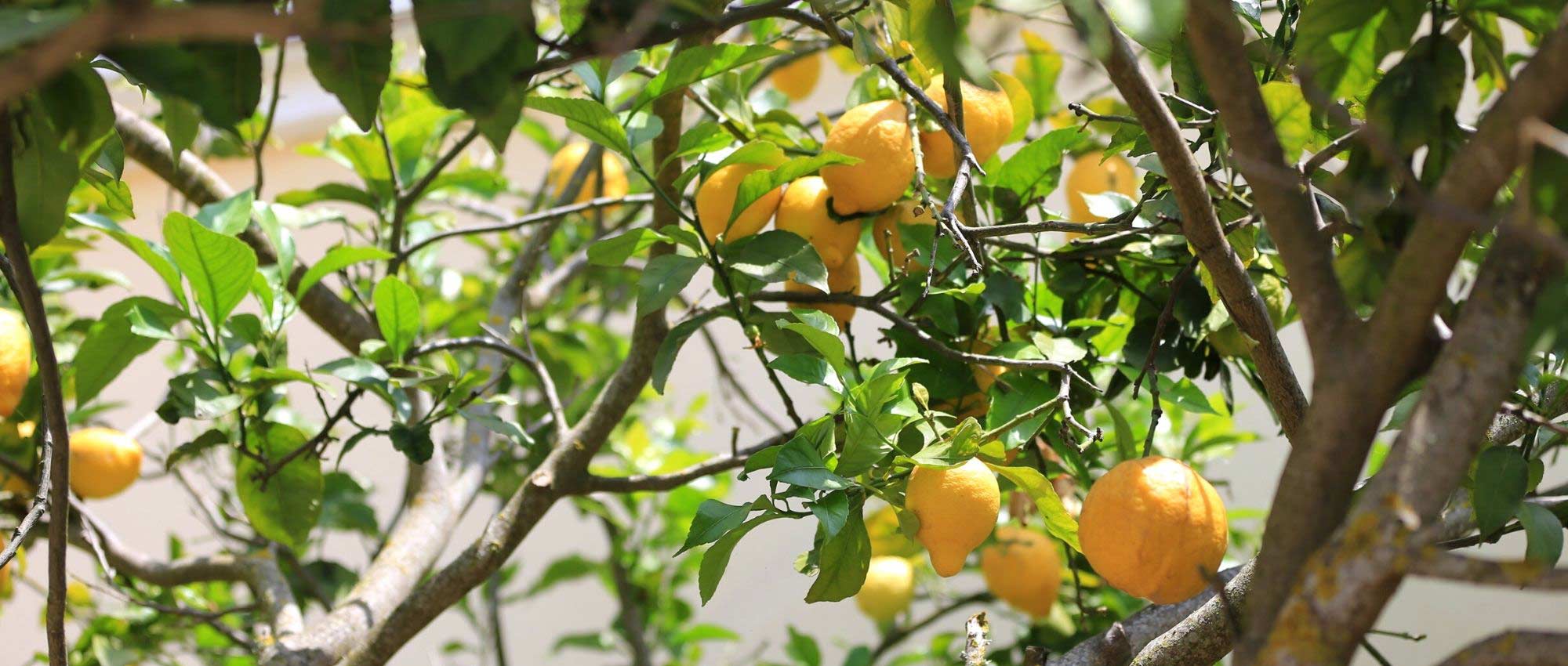
Diseases and parasitic organisms of lemon trees
Recognise symptoms and treat
Contents
Lemon tree is prized for its juicy, tangy fruit, of a beautiful yellow colour, very rich in vitamin C. It bears beautiful white, scented flowers and glossy green foliage. It is a frost‑tender citrus that must be grown in a pot and brought indoors for winter, except on Mediterranean coast where it can be planted in ground. Unfortunately, it is susceptible to various diseases that reduce fruit production, make it less attractive or sometimes threaten its survival. Before anything else, it is important to point out that disease risks are lower when lemon trees are grown in suitable conditions: protection against cold, regular watering but without excess, clean pruning with application of a sealing compound, etc. Your lemon trees will thus be much less fragile and will resist diseases and parasitic organisms better! If they nevertheless show symptoms of disease, discover our advice for dealing with them and be able to enjoy a good harvest.
Brown rot
Description
Brown rot is a fungal disease caused by the fungus Monilia sp. that affects many fruit trees (lemon tree but also plum, apple and cherry trees…). It is not dangerous for the bush, but it damages the fruit!
Symptoms
Fruits rot while remaining attached to the tree. A brown spot appears first, which enlarges and eventually affects the entire fruit, with white pustules arranged in concentric circles. The fruit eventually rots entirely and dries out.
How to treat it?
Prevention:
- Boost your lemon tree’s defences by spraying horsetail decoction, diluted to 20%.
- If you prune the bush, disinfect tools and apply a wound sealant.
Treatment:
- As soon as you spot any, remove affected fruits immediately to prevent the disease from spreading (do not compost them!).
- We recommend pruning the branches that bear them, taking care to disinfect tools thoroughly. Also apply a wound sealant.
- Burn the fruits and branches you have removed.
- You can also use a fungicide such as Bordeaux mixture.
- Essential oils of oregano and savoury also help to fight brown rot.
Gummosis

Gummosis appears as a translucent substance flowing from trunk or branches (photos: Scot Nelson / Malta)
Description
Gummosis is a disease caused by wounds, poorly healed pruning wounds or fungi such as Phytophthora. The bush then secretes gum, a defence mechanism against a pathogenous agent. Gummosis can be associated with another fungal disease, such as brown rot for example.
Symptoms
- On branches or trunk, a translucent substance (gum) of amber colour can be seen oozing. It generally appears at site of a wound.
- Bark tends to be deformed, swollen.
How to deal with it?
Prevention
- Take care not to wound bush.
- When pruning is required, disinfect tools and apply wound sealant to protect plant.
- Avoid excess moisture and waterlogged soils, as these favour gummosis.
- You can also whitewash trunk with limewater
Treatment
As soon as gum is noticed, act quickly and treat as soon as possible:
- If branch on which gum appears is relatively thin, remove it with a clean, neat pruning cut using disinfected tools.
- If branch is larger, scalp wound, then apply a fungicide such as Bordeaux mixture, as well as a wound sealant.
Discover other Lemon trees
View all →Available in 2 sizes
Available in 1 sizes
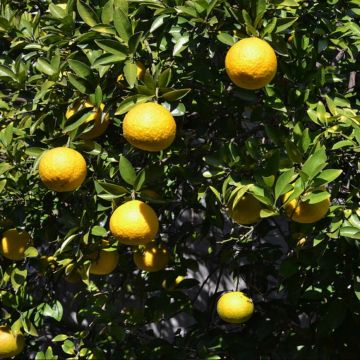
Available in 2 sizes
Available in 1 sizes
Available in 2 sizes
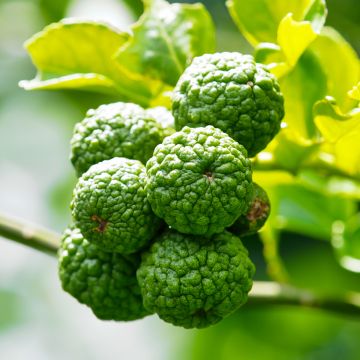
Available in 3 sizes
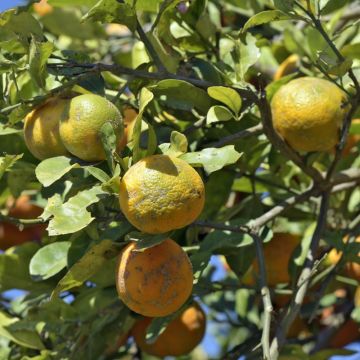
Available in 1 sizes
Available in 3 sizes
Available in 2 sizes
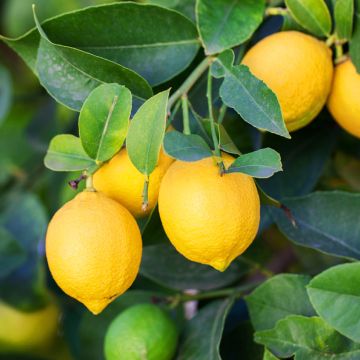
Available in 3 sizes
Mal Secco
Description
Mal Secco is a very serious disease caused by a fungus, Phoma tracheiphila, which blocks sap circulation in the bush. If left untreated, it can cause death of the bush within two to three years at most. It affects various species of citrus trees.
Symptoms
- Sap can no longer circulate properly, so leaves discolour and dry out, and branches die back quickly. Disease first affects those at plant extremities, but may then lead to dieback of the whole bush.
- Bush tends to produce suckers at base of its trunk.
- When cutting branches, an orange-coloured discolouration can be seen in the wood.
How to treat it?
Prevention
- Take care not to wound trees.
- When pruning, disinfect tools and apply healing putty.
Treatment
- As soon as you have identified this disease, cut and burn affected branches (do not compost them!). Then apply fungicidal product to the wounds. There is no other effective curative treatment.
- If your bush is widely affected, best option is to uproot it and burn it, to prevent it contaminating other plants.
Sooty mould

Sooty mould is characterised by a black deposit on leaves, which limits photosynthesis (photos: Scot Nelson)
Description
It is a fungus that develops on honeydew secreted by mealybugs, aphids and whiteflies. This condition is not serious but it limits photosynthesis.
Symptoms
- Leaves become covered with a black, soot-like deposit.
- Leaves are also sticky because of honeydew produced by insects.
- Although unsightly and limiting photosynthesis, this is not a serious disease and plant life is not endangered.
How to deal with it?
Prevention
- Look for presence of insects such as mealybugs and aphids, and treat to eliminate them.
- If leaves become sticky, we recommend cleaning them to remove honeydew, as sooty mould develops on it.
Treatment
- Clean leaves with a cloth soaked in water and black soap. You can remove the most affected leaves.
- Identify insects (mealybugs, aphids, whiteflies) and treat with black soap, for example.
Deficiencies
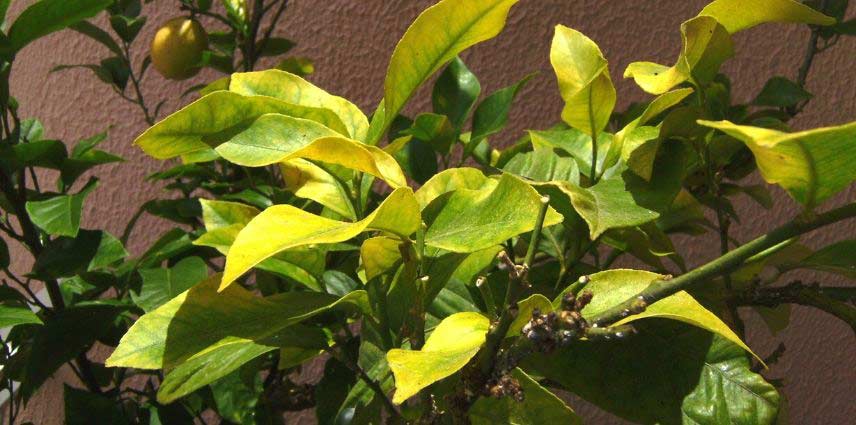
Yellow leaves on a lemon tree caused by chlorosis
Description
Plant lacks nutrients, notably iron (iron chlorosis). Iron uptake can be blocked by lime present in soil, preventing plant from carrying out photosynthesis.
Symptoms
- Leaves turn yellow between veins. They may eventually fall.
- Bush becomes less vigorous and produces fewer flowers and fruits.
How to remedy it?
- Apply fertiliser to feed plant.
- In case of iron deficiency, use an anti-chlorosis product. Mix product with water, then water plant with this solution.
- If substrate is calcareous, repot bush into neutral, well-draining substrate, for example horticultural compost mixed with coarse sand and well-rotted compost.
- Water with rainwater rather than tap water, which may be too calcareous.
Aphids

Aphids are small insects that settle on plant and extract sap (photos: Scot Nelson / MedievalRich)
Description
Well known to gardener, aphids are small parasitic insects that settle on leaves and young shoots to extract sap, weakening plant. They can also transmit diseases.
Symptoms
- Leaves become distorted and curl in on themselves. They tend to yellow and dry out.
- They become sticky due to honeydew secreted by aphids, and black spots of sooty mould may appear on foliage.
- Aphids are visible to the naked eye.
How to deal with it?
- Best solution is to spray foliage with black soap diluted in water.
- You can also use an insecticidal product based on pyrethrum.
- Garlic decoction and nettle manure are also effective against aphids.
Whiteflies
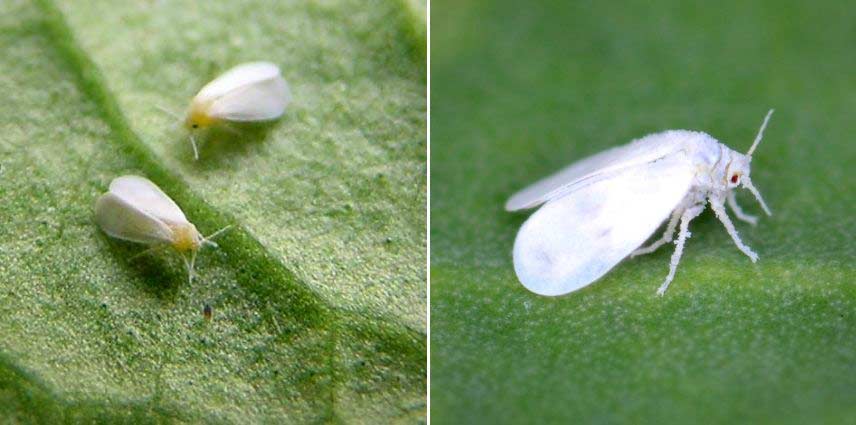
Aleurodes, also known as whiteflies (photos: gaucho / Amada44)
Description
Whiteflies are small white flies that pierce plant tissues to extract sap. They develop mainly indoors, in dry, confined environments.
Symptoms
- Whiteflies can be seen taking flight as soon as foliage is touched.
- Leaves become sticky due to honeydew secreted by whiteflies.
How to deal with them?
- Regular ventilation and misting of foliage will limit their development.
- If it’s not too cold, you can also move the pot outdoors.
- Spray foliage with black soap diluted in water.
- You can also use rose geranium essential oil.
Scale insects
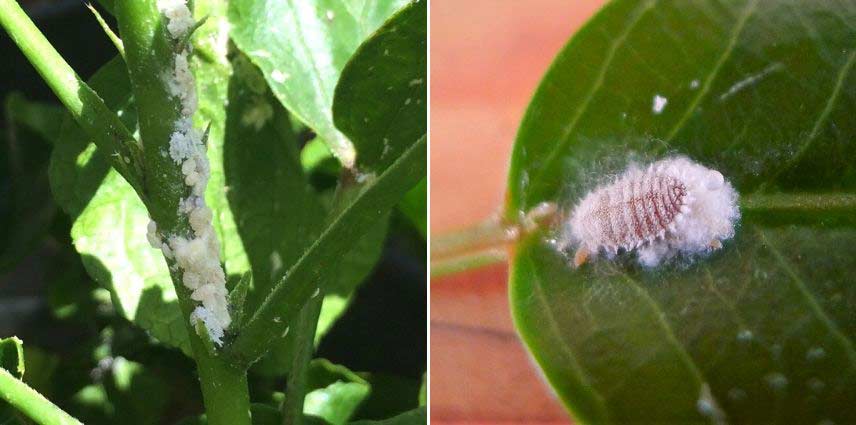
A lemon tree attacked by mealybugs (photos: Scot Nelson / gailhampshire)
Description
Scale insects are small insects that pierce plant tissue to feed on sap. On citrus trees, it is mainly mealybugs that cause problems (notably species Planococcus citri).
Symptoms
- The honeydew they secrete makes leaves sticky and can lead to sooty mould (black deposit on foliage). Plant becomes weakened, which limits flowering and fruiting.
- Insects may be visible as small white, cottony clusters.
How to deal with them?
- Check whether you can spot these small insects. If so, make a solution by diluting in one litre of water a little black soap, vegetable oil and 90% alcohol. Dampen a cloth with this solution and wipe it over the foliage.
- Also don’t hesitate to remove scale insects you spot by hand.
Leafminer of citrus trees
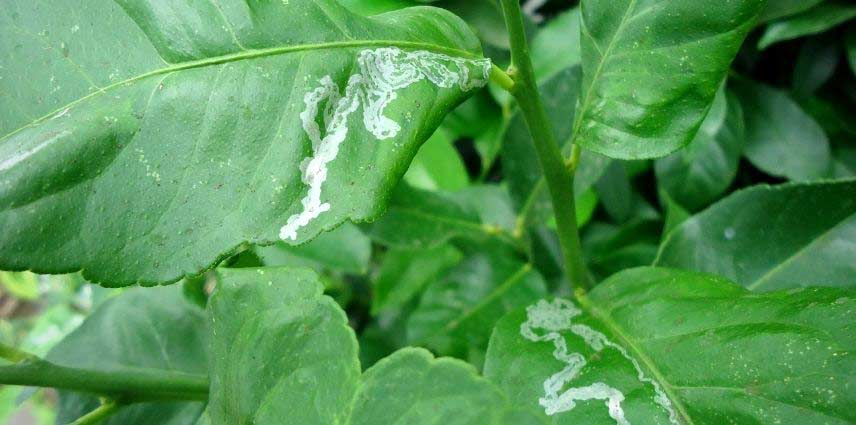
Discoloured sinuate patches are a sign of an attack by the leafminer of citrus trees (photo: Scot Nelson)
Description
The larva of this small moth (Phyllocnistis citrella) creates mines within leaves and feeds on leaf tissues. It mainly attacks young, tender leaves.
Symptoms
- On leaves, discoloured sinuate trails are visible to the naked eye. Leaves also tend to curl, yellow and dry out.
- Larvae are present under leaves.
How to deal with it?
- First, remove and burn affected leaves.
- Outdoors, use pheromones installed in a trap at the start of spring. This attracts males and prevents reproduction.
Citrus leaf miner
Description
This is a small moth, Prays citri, whose female lays eggs on flower buds of lemon tree. Caterpillars hatch, enter young developing flowers and devour them from inside. This prevents bush from producing fruit.
Symptoms
- Flower buds are damaged and dry out.
- Bristle threads can be seen on flowers and flower buds.
- Fruits are fewer, small and deformed, or absent.
How to deal with it?
- Start by removing affected flower buds.
- You can set pheromone traps, which will attract males and limit reproduction.
- If that is insufficient, spray organic insecticidal product based on Bacillus thuringiensis.
Red spider mites

Red spider mites are tiny mites that suck sap and spin webs on the bush (photos: Paramecium / Gilles San Martin)
Description
They are tiny mites that settle on plants, pierce them and empty the contents of their cells. Their minute size makes them hard to see with naked eye. If conditions are favourable, they multiply very quickly and proliferate.
Symptoms
- Leaves show small yellow or discoloured specks. They eventually dry out and fall off.
- Small webs may be seen on leaves and stems.
How to deal with them?
Prevention
- Avoid hot, dry conditions, which are particularly favourable to red spider mites.
- Mist foliage from time to time.
- Take the bush outside when temperatures allow.
Treatment
- As they dislike humidity, you can eliminate them by spraying water on the foliage and improving ventilation.
- As a last resort, spray an acaricide.
- Subscribe!
- Contents
